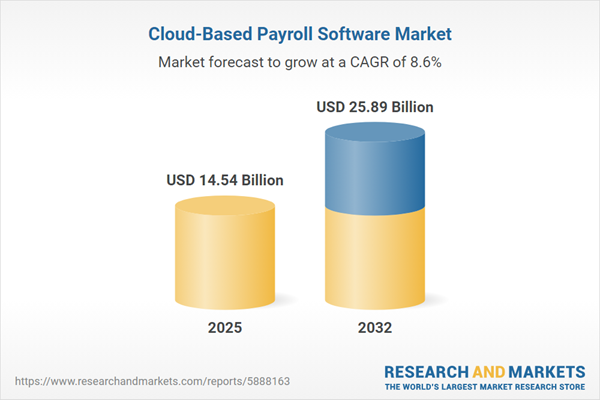Speak directly to the analyst to clarify any post sales queries you may have.
Cloud-based payroll software represents a transformative opportunity for organizations aiming to modernize HR and finance operations. As senior decision-makers seek agile solutions that address evolving workforce and compliance requirements, these technologies offer modular, adaptable capabilities to support strategic alignment and operational efficiency.
Market Snapshot: Trends and Growth in the Cloud-Based Payroll Software Market
The cloud-based payroll software market is expanding on the strength of rising HR automation and increased demand for digital workforce solutions. Estimated at USD 13.36 billion in 2024, with projections reaching USD 14.54 billion by 2025 and USD 25.89 billion by 2032, the sector demonstrates a compound annual growth rate of 8.61%. Organizations are prioritizing platforms that streamline operations through efficient integration, advanced compliance features, and robust payroll processing. Industry leaders are focusing investments on modular solutions capable of adapting to regulatory shifts, enabling flexibility, and ensuring compliance for globally distributed enterprises. This demand reflects the push for scalable payroll systems that handle multi-jurisdictional complexity with precision.
Scope & Segmentation of the Cloud-Based Payroll Software Market
This report thoroughly examines the cloud-based payroll software landscape, focusing on drivers of adoption and the diverse requirements organizations face. The analysis covers:
- Organization Size: Solutions address the scalability needs of large enterprises, midmarket companies, and small businesses, each with unique flexibility requirements.
- Industry Vertical: Adoption patterns and compliance challenges differ between sectors such as financial services, healthcare, technology, telecommunications, manufacturing, and retail, shaping specific best practices.
- Component: Key features include customizable analytics, reporting, employee self-service, tax and payroll management, and integrated time tracking, offering operational visibility and control.
- Deployment Mode: Vendors provide private, public, and hybrid cloud models to help organizations balance security, risk, and integration with existing infrastructure.
- Service Type: Services range from consulting and initial implementation to ongoing maintenance and user support, ensuring seamless adoption throughout the software lifecycle.
- Geographical Coverage: The report assesses regional trends and challenges in the Americas, Europe, Middle East, Africa, and Asia-Pacific, examining the interplay between local adaptation and standardization.
- Key Vendors: Profiles of Automatic Data Processing, Paychex, Intuit, Ceridian HCM, Workday, UKG, Oracle, SAP, Paycom, and Paylocity highlight approaches to regulatory change and evolving business needs.
Key Takeaways for Senior Decision-Makers
- Cloud-based payroll ensures consistent processes and improved compliance for organizations with complex, global workforces.
- The integration of artificial intelligence and workforce analytics allows for real-time, data-driven payroll modifications and enhances talent management decisions.
- Subscription models optimize budgeting and facilitate automatic updates, aligning payroll systems with legislative developments and shifting business requirements.
- Advanced integration capabilities make it easier to respond to new HR and finance policies, bolstering organizational adaptability and operational resilience.
- Mobile and self-service options increase payroll transparency and empower employees to access and manage their own information securely.
- Partnering with vendors and technology providers smooths the transition to cloud-based solutions while reducing compliance risks and minimizing disruptions.
Tariff Impact on Cost Structures and Supply Chain
Recent adjustments to U.S. tariffs on data center and network hardware are prompting payroll software providers to revisit supply chain strategies. Enterprises are consolidating vendor partnerships, renegotiating contracts, and streamlining procurement processes to secure payroll continuity and maintain system reliability in the face of supply fluctuations.
Methodology & Data Sources
This analysis draws from executive interviews, insights from leading payroll software vendors, and a detailed examination of industry and regulatory data. The approach integrates multiple sources to ensure recommendations are objective and suitable for current technology adoption and HR planning objectives.
Why This Report Matters
- Supports benchmarking of payroll transformation initiatives against evolving compliance expectations and technology trends.
- Clarifies how regulatory dynamics and operational challenges influence risk management and investment strategy across various sectors and regions.
- Equips leadership teams with relevant guidance to scale digital workforce automation strategies as their organizations grow.
Conclusion
Cloud-based payroll platforms enable organizations to achieve lasting transformation in HR and finance by supporting compliance, process innovation, and sustainable performance. Decision-makers can leverage these insights to align payroll strategies with operational and regulatory demands.
Additional Product Information:
- Purchase of this report includes 1 year online access with quarterly updates.
- This report can be updated on request. Please contact our Customer Experience team using the Ask a Question widget on our website.
Table of Contents
3. Executive Summary
4. Market Overview
7. Cumulative Impact of Artificial Intelligence 2025
Companies Mentioned
The companies profiled in this Cloud-Based Payroll Software market report include:- Automatic Data Processing, Inc.
- Paychex, Inc.
- Intuit Inc.
- Ceridian HCM Holding Inc.
- Workday, Inc.
- UKG Inc.
- Oracle Corporation
- SAP SE
- Paycom Software, Inc.
- Paylocity Holding Corporation
Table Information
| Report Attribute | Details |
|---|---|
| No. of Pages | 187 |
| Published | November 2025 |
| Forecast Period | 2025 - 2032 |
| Estimated Market Value ( USD | $ 14.54 Billion |
| Forecasted Market Value ( USD | $ 25.89 Billion |
| Compound Annual Growth Rate | 8.6% |
| Regions Covered | Global |
| No. of Companies Mentioned | 11 |









